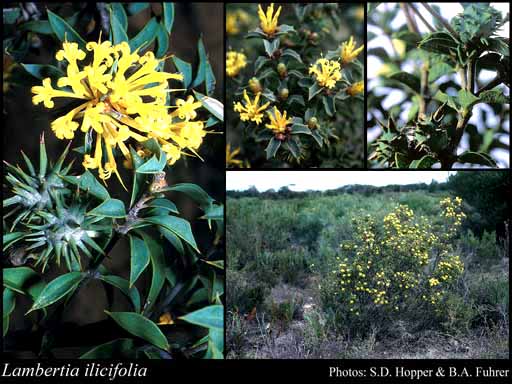- Reference
- Icon.Pl. 6:Tab.553 (1843)
- Conservation Code
- Not threatened
- Naturalised Status
- Native to Western Australia
- Name Status
- Current
Erect, prickly, densely-branched shrub, to 2 m high. Fl. yellow/orange, Aug to Nov. Grey or yellow sand, sandy loams & clays, gravel, laterite. Sandplains, hills, slopes & rises, railway reserve.

Scientific Description
Shrubs; branchlets glabrous or hairy. Leaves whorled, 12-20 mm long, 5-10 mm wide, glabrous; lamina flat, widest around the middle, once divided, pinnately divided, entire or shallowly divided, the margins flat; apex pungent, 0.8-1 mm long. Inflorescences yellow; innermost bracts 7-10 mm long. Perianth 11-17 mm long, hairy; pistil 10-15 mm long, style hairy. Flowers in August, September, October or November. Occurs in the South-west (SW) Botanical Province(s), in the Avon Wheatbelt (AW), Jarrah Forest (JF) or Mallee (MAL) IBRA subregion(s).
Distribution
- IBRA Regions
- Avon Wheatbelt, Jarrah Forest, Mallee.
- IBRA Subregions
- Katanning, Merredin, Northern Jarrah Forest, Southern Jarrah Forest, Western Mallee.
- Local Government Areas (LGAs)
- Corrigin, Cuballing, Dumbleyung, Kent, Kojonup, Kulin, Lake Grace, Narrogin, Quairading, Wagin, Wickepin, Williams, Woodanilling.